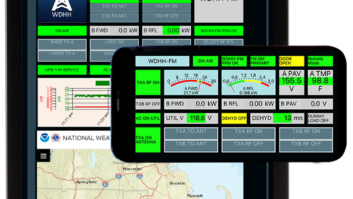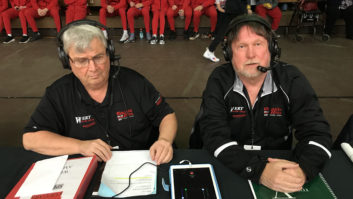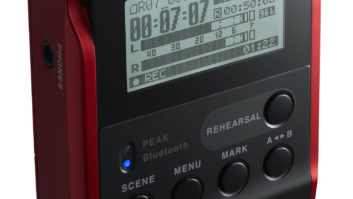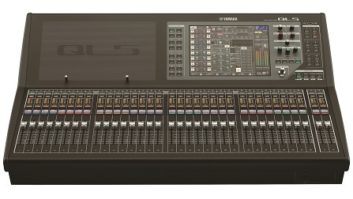Side by Side: Mics for Smartphones
Jan 6, 2013 8:00 AM, By Chriss Scherer, editor
The smartphone has become everyone’s multi-tool. Recording and editing audio on one is common. But does the on-board mic provide the quality you really want? Reports to Radio magazine say the mics (there are three) on the iPhone 5 are good enough to be used on air. But if you don’t like the on-board mic what can you do?
There are two basic options: Connect to the docking port (at least up to the iPhone 4) or use the TRRS mic/headphone jack. We found docking adapters for the iPhone, but with the redesigned connector on the iPhone 5, some of these devices are useless. There are adapters to connect 4 and earlier jacks to the 5. And if you’re not using an iPhone, your only real option is the TRRS jack.
For iPhone version 4 and earlier, there are stereo mics that clip to the connector, including the Tascam Ixz, Logitec LIC-iREC03P and Blue Mics Mikey. There are also adapter housings that provide mic jacks, including the Fostex AR-4i and Tieline MicAdapter.
The iPhone connector allowed a stereo connection, but the TRRS jack is a mono input. It appears the TRRS jack is common regardless of the phone’s manufacturer. With that in mind, we looked at ways to connect to the jack.
The 3.5mm jack has four connections: left and right audio out, mic in and a ground return. The extra ring on a TRRS shifts the ground from the sleeve to the second ring and uses the sleeve for the mic connection.
We found two options to connect a mic to the jack: a plug-in mic that sticks out of the phone or an adapter cable to connect a mic and sometimes a headset.
IK Multimedia iRig Mic Cast

iRig Mic Cast is an ultra-compact portable voice recording microphone. It features a tight unidirectional pickup pattern that minimizes background noise making it ideal for single-source audio recording. In addition to an incredibly flat frequency response with zero tonal coloration, the iRig Mic Cast features a stereo mini-jack headphone output, mini-switch for two sensitivity settings, adjustable desktop stand, bumper-friendly mini-jack connector, and iRig Recorder and VocaLive apps.
ikmultimedia.com
IK Multimedia IK iRig Pre

This microphone preamp allows any mic with an XLR connector to be connected to a smartphone. The adjustable thumb wheel gain control sets the level. The onboard 9V battery provides voltage for phantom-powered condenser microphones for at least for 15 hours of continuous use. The 3.5mm stereo headphone output allows for monitoring. A Velcro strip slot allows the unit to be mounted on a mic stand or other convenient spot.
ikmultimedia.com
MicW i456

The i456 is a wide cardioid microphone for general purpose audio recording. The mic is 5.6cm long and has a frequency response of 20Hz to 20kHz. The source impedance is less than 2.2kOmega;. The cardioid pattern has a sensitivity of -50dB. The electret mic is powered by the phone’s jack. The company also manufactures the i436 precision mic, the i266 high-sensitivity mic and the iShotgun.
mic-w.com
Vericorder XLR with Preamplifier

This adapter breaks out the 3.5mm TRRS phone jack to an XLR input and 3.5mm TRS headphone jack. The adapter includes a preamplifier with 6.1dB gain that is powered by the smartphone. Frequency response is 20Hz to 20kHz. The mic cable is about 2′ long. The company also makes the Mini Mic, which plugs directly in the TRRS jack.
vericorder.com
Roll your own

The TRRS plug connections are shown at right. Making an adapter cable is not difficult if you can find the plug. A basic adapter can be made to simply connect a mic with a TRRS to TRS or TRRS to XLR cable. Adding the TRS headphone jack is an option.
Many apps will not provide a confidence recording output when the mic is in use. Having the headphone jack saves you from having to unplug the mic and connect headphones between takes.
Some notes on the TRRS connector. In our research, we saw some reports that an iPhone may not always detect the attached mic when a home-built adapter is used. One website suggested adding a 1kOmega; resistor across pins 2 and 3 of the XLR connector.
There is a bias voltage on the TRRS jack. We also saw references to placing a capacitor in series with the mic connection, but we saw just as many posts saying it wasn’t necessary because a dynamic mic will ignore the bias signal.
January 2013
The studios of JENNiRADIO, making HD Radio more than just a jukebox, testing antennas with a network analyzer, and Field Reports on the Tieline Report-IT and Deva Broadcast SmartGen Mini….












